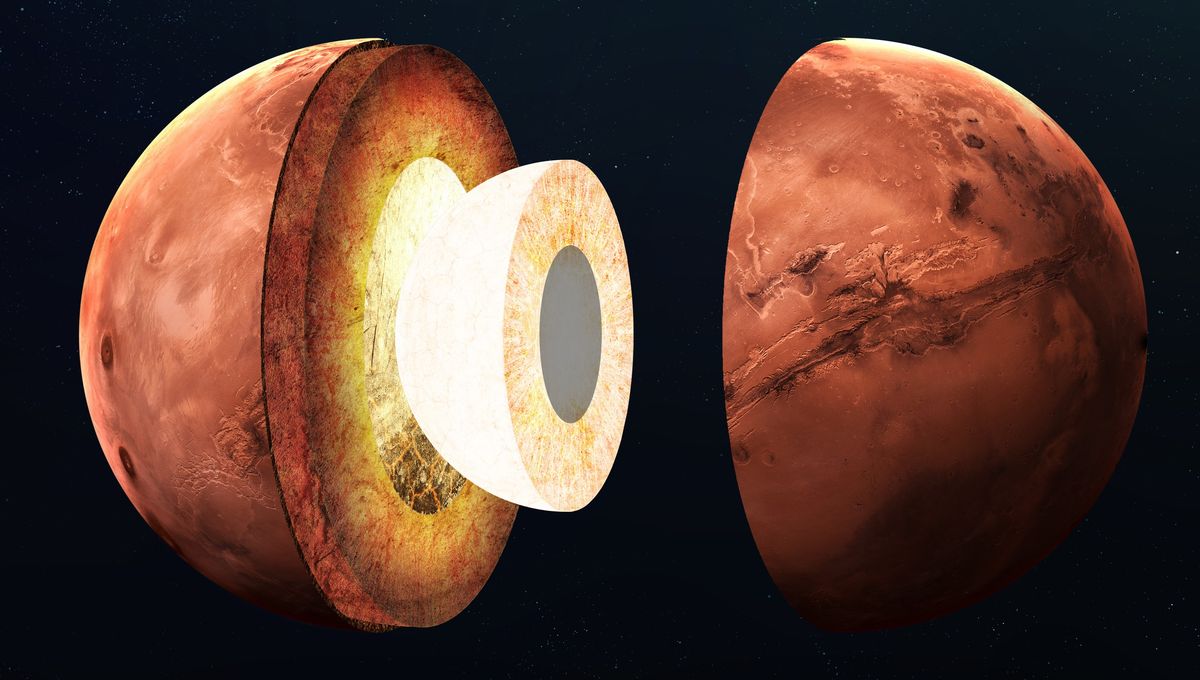
Slowly but surely, humanity is better understanding the interior of Mars and with that, what the early Solar System was like. We know that Mars used to be a lot more like the Earth, with water on its surface. Today, Mars is a frigid desert, but deep inside it might retain similarities. One perhaps is a solid inner core, just like Earth.
The rest of this article is behind a paywall. Please sign in or subscribe to access the full content.
Let’s not imagine that Mars is in any way Earth-like, even bone-deep. Just last week, researchers revealed that while Earth has a fluid mantle, Mars’ mantle is a little bit like nougat, with chunks from ancient collisions. Those findings and new ones about the core come from data collected by NASA’s InSight mission. The lander was equipped with a seismometer.
Over its four years of work, two years of primary and two years of extended mission, the probe recorded over 1,000 marsquakes – some caused by meteorites, most from the planet itself. Mars is not an active world, so most of them were very weak. Still, researchers were able to use 23 signals to study how the seismic waves moved through the core, even seeing a velocity shift in the waves. This is considered a clear indication of a solid inner core.
“We estimate that Mars’s solid inner core is about 600 kilometers [373 miles] in radius and the seismic waves speed up by approximately 30 percent as they cross from the liquid outer core into the solid inner core. These findings suggest that the inner core should contain distinct light elements, separated from the outer core,” corresponding author Professor Daoyuan Sun, from the University of Science and Technology of China, told IFLScience.
InSight was a revolutionary mission, but the data that has been sent back comes with caveats. While on Earth, we study the interior of our planet thanks to thousands of seismometers, Mars only had one. Quakes on Earth can be much stronger. The strongest one on Mars, S1222a, was a magnitude 4.7 quake, believed to be a release of stress in the Cerberus Fossae region. Several of the strong ones were from meteorite impacts and were not useful in this work, due to their lack of low-frequency waves.
“Studying marsquakes is tough,” Professor Sun told IFLScience. “Perhaps the most important challenge is making sure the signals we detect really are from the core. To address this, we ran extensive tests and were able to confirm that these signals are real features. Even better, we identified multiple inner core-related phases that cross-check and support each other.”
Sun highlighted the contribution of the women scientists who make up most of his team, Huixing Bi, Ningyu Sun, and Zhu Mao, stressing how the work of Inge Lehmann, the discoverer of Earth’s inner core, continues to inspire a new generation. He also stressed that the work done on Mars is not happening in a vacuum.
“Our findings build on years of work by the InSight team and scientific community, including growing catalogs of Marsquakes, improved models of Mars’s interior, and a better understanding of Marsquake signals. We hope these efforts will continue and be strengthened by future planetary missions,” Professor Sun told IFLScience.
The study is published in the journal Nature.
Source Link: Marsquakes Reveal A Solid Inner Core In The Red Planet